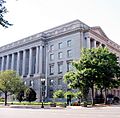Internal Revenue Service facts for kids
| IRS | |
 |
|
| Agency overview | |
|---|---|
| Formed | July 1, 1862 (though the name originates from 1918) |
| Jurisdiction | Federal government of the United States |
| Headquarters | Internal Revenue Service Building 1111 Constitution Ave., NW; Washington, DC 20224,U.S |
| Employees | 79,890 (2015) |
| Annual budget | $11.4 billion (2015) |
| Agency executive |
|
| Parent agency | Department of the Treasury |
The Internal Revenue Service (IRS) is the part of the Federal government of the United States responsible for collecting taxes and enforcing tax laws. The IRS decides how much tax is owed and collects the revenue on a regular basis. The IRS is the largest bureau in the United States Department of the Treasury. It is one of the world's most efficient tax collection agencies. The IRS processed over 224 million tax forms and collected over $2 trillion in revenue in 2004.
History
Beginning in 1791, the federal government was supported by taxes on distilled beverages, tobacco, sugar, corporate bonds and slaves. These were indirect taxes, the only kind permitted by the United States Constitution. In 1812, the cost of the war added the first sales taxes on gold, jewelry, and silverware. In 1817, the government did away with all these taxes and relied on the funds from tariffs on imported goods.
During the American Civil War, funds were needed to finance the war. In 1861, Congress drafted a bill for a direct tax on personal and corporate income. This first income tax charged 3% on incomes over $800. The bill passed both houses of Congress but never went into effect. In 1862, however, Abraham Lincoln signed a bill that called for a 3% tax on incomes between $600 and $5,000, 7.5% on incomes between $5,000 and $10,000 and 10% on incomes over $10,000. There were debates in Congress over the constitutionality of the direct income tax, but no action was taken. It was allowed to expire in 1872 when it came up for renewal.
In 1862, Congress had authorized the office of Commissioner of Internal Revenue. Much as today, he had the power to assess, levy and collect taxes. He also had the right to enforce the tax laws by prosecution and seizing property and income. George S. Boutwell was the first commissioner of the Bureau of Internal Revenue. / In 1894, Congress passed the Wilson-Gorman Tariff. It reduced the Tariffs on certain imports into the United States. However, it made up for this by charging a 2% direct income tax. The Supreme Court, in Pollock v. Farmers' Loan & Trust Co ruled the income tax unconstitutional a year later. The Court ruled that the Constitution did not allow an income tax without apportionment among the states.
On February 3, 1913, the Sixteenth Amendment to the United States Constitution was ratified. Free of the critical apportionment issue, it allowed Congress to impose an income tax. The Bureau of the IRS was charged with collecting income taxes. Personal income tax was 1% on income above $3,000. Incomes over $5,000 were subject to an additional 6% tax. Income taxes were as high as 77% in 1918 to help finance World War I. In 1929 they dropped to a high of 24% but rose again during the Great Depression in 1929. During World War II withholding and quarterly taxes were introduced.
In 1953, the Bureau of Internal Revenue reorganized and changed its name to the Internal Revenue Service.
In 1998. the IRS Restructuring and Reform Act again reorganized and modernized the agency. Taxpayer rights were further expanded.
Images for kids
-
Internal Revenue Service Building on Constitution Avenue in Washington, D.C.
-
George S. Boutwell was the first Commissioner of Internal Revenue under President Abraham Lincoln.
-
New York City field office for the IRS.
See also
 In Spanish: Servicio de Impuestos Internos de los Estados Unidos para niños
In Spanish: Servicio de Impuestos Internos de los Estados Unidos para niños









